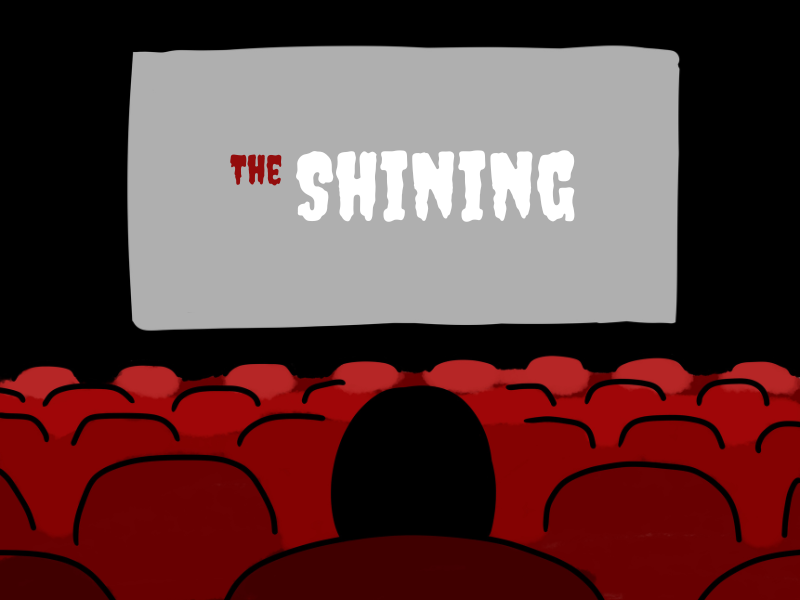All work and no play makes me a dull writer, but reviewing Stanley Kubrick’s 1980 film “The Shining” just in time for Halloween is the opposite of boring. As a self-described horror film fiend, I’m proud of my lack of reaction when it comes to jump scares, gore and stereotypical film violence — 2017’s “It” has nothing on me, and don’t even get me started on 2021’s “Fear Street” — yet “The Shining” got to me in a way that no other film ever could, making it a perfect flick for this Halloween. Unlike other horror films, “The Shining” doesn’t try to terrify you with blood or cheap scares. Instead, it frightens you by portraying a slow descent into madness, enhancing viewers’ sense of unease and dread from the very first scene onto the last.
Originally a novel by Stephen King, “The Shining” was directed by acclaimed filmmaker Kubrick. He diverged strongly from the original text (much to King’s chagrin) but his masterful directing and storytelling make up for the discrepancies. The film follows aspiring writer Jack Torrance (Jack Nicholson), who takes a job as the sole caregiver of the isolated Overlook Hotel over the winter, bringing his wife Wendy (Shelley Duvall) and their five-year-old son Danny (Danny Lloyd). However, all is not as it appears at this seemingly idyllic sanctuary free from the ills of the rest of the world: the Overlook Hotel is notorious for inducing madness in its caregivers, and the vengeful spirits that reside there are eager for new ghostly residents.
Throughout “The Shining,” we bear witness to Jack’s complete mental deterioration, symbolized in the film through its stark color schemes, eerie music and sweeping shots. The scenes are drawn out and tense, contributing to the overall sense of isolation that is only exacerbated by the lack of regular side characters. Other horror films often have a random character that is killed early on in the movie, but this one forces viewers to focus solely on the Torrance family; after all, there is no one else in this completely emptied hotel to pay attention to. It is perhaps because of this forced attachment to the three main characters that Jack’s psychosis is all the more terrifying: complete isolation like this could drive anyone insane, even without the interference of supernatural forces.
Indeed, what I found most terrifying was not the floor overflowing with blood, creepy twins or “redrum” — it was the realism. Although “The Shining” is a supernatural movie, Nicholson plays Jack’s mental turmoil with shocking authenticity, his chilling demeanor and wild-eyed expression selling us on the notion that Jack has fully gone mad.
Duvall also shines in her role as Wendy, delicately toeing the line between her vulnerability around her aggressive husband and her strong maternal instincts to save her son (and herself). Despite Wendy’s intense and understandable fear, she is far from a helpless damsel-in-distress; she truly embodies the “mama bear” stereotype and channels her terror into action against her husband. It’s rare to see victims in horror movies put up a real fight (leading to lots of jokes over why horror movie characters are stupid), so seeing such a strong character, even in the face of her immense fear, was refreshing.
“The Shining” is perhaps most known for its iconic ax scene, where Jack declares, “Here’s Johnny!” before hacking away at a door to try and kill his panicked wife. The scene has become a meme in the cultural sphere, and even though I was expecting it, I was still on the edge of my seat throughout the entire sequence. Kubrick’s masterful use of cuts, unique camera angles and character framing makes the scene feel intensely real. Viewers are truly present with Wendy as she desperately tries to protect herself against Jack’s wrath. Kubrick employs similar techniques throughout the film, pushing viewers to immerse themselves in the happenings of the Overlook Hotel and feel like a part of the action.
Danny, also a complex and compelling character, rounds out the Torrance family. Danny has a special ability called the shining, which allows him to understand things about the world that others miss. A memorable moment occurs when Danny rides his tricycle down a long hallway, only to stumble upon a pair of sisters dressed in blue that desperately want to play with him. One might expect that Danny, being a child, would not really have an important role, especially for a movie of this genre, but this is not the case. Instead, Danny — in part thanks to his shining ability — moves along much of the plot and ultimately saves the day, making viewers feel like every scene and character in the film is purposeful and useful.
“The Shining” has a very low death count for a horror movie, with only one on-screen murder. Gore, similarly, is used sparingly. These decisions do not detract from the terrifying nature of the film; rather, they make it all the more impactful since they force viewers to consider the psychological horrors wrought by utter desperation. “The Shining” shines through its subtle mental warfare and uniquely realistic delve into the turmoils of isolation.
This Halloween, instead of a gore-fest, turn on this classic. You won’t regret it.
Editor’s Note: This article is a review and includes subjective thoughts, opinions and critiques.
